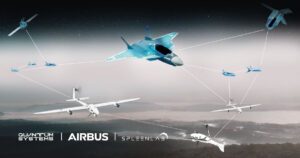
Quantum Systems, Airbus Defence and Space Partner on Research of AI-Enabled UAV Swarming Technology
by DRONELIFE Staff Writer Ian M. Crosby
Airbus Defence and Space GmbH, Quantum-Systems GmbH and Spleenlab GmbH have been awarded a research endeavor from the Planning Office of the German Armed Forces to demonstrate and analyze the AI elements necessary for swarms of tactical UAS in a real-world scenario. With a focus on the effectiveness of tactical UAS, the project known as KITU 2 (Künstliche Intelligenz für taktische UAS; Artificial Intelligence for tactical UAS) is being funded by the German Ministry of Defence. This partnership will allow each company to provide its key strengths.
Airbus Defence and Space will provide swarming algorithms, simulation environments and experimental hardware, as well as required AI building blocks.
Quantum Systems offers the Vector 2-in-1 tactical aerial reconnaissance platform with built in AI edge-computing capabilities. This platform, can be deployed as fixed-wing eVTOL Vector or as the multicopter Scorpion UAS, allows for heterogenous swarms. The company is currently developing a family of systems strategy to introduce their smaller and bigger platforms into the market in 2024 and 2025 and grant customers a seamless layered approach to range, flight time and payload capabilities.
Spleenlab will leverage its expertise in AI edge software for swarming, incorporating object recognition and robust navigation methods in communication denied environments.
Since 2018, the joint Main Ground Combat Systems (MGCS) program of France and Germany has been working on a new weapon system to augment the defensive and offensive capabilities of main battle tanks through the integration of next generation technology and multiple platforms. Meanwhile, in the Future Combat Air System (FCAS) program, France, Germany, and Spain are developing a system involving manned new generation fighters, unmanned aircrafts, and new weapons and communications systems.
Both of these programs intend to incorporate multi-platform and multi-vehicle swarming on the battlefield and will benefit from the KITU 2 program. Swarming allows for force multiplication through the control of multiple UASs with a smaller ground or air crew. Additionally, first studies from the ongoing war in Ukraine demonstrate that multiple smaller and lower cost UASs may be more effective at providing aerial reconnaissance from the battlefield due to the coverage of a wider area and the ease of replacing a lost drone.
Read more:
- Transforming Mining Operations with Drones: Strayos Partners with Quantum Systems
- Intelligent Drone Swarms Could Mimic Bird Flocks: New Research from University of Houston
- Drones for Ukraine: Quantum Systems Sends Long Endurance Vectors
- Quantum Systems Funding: New Investors for Advanced eVTOL
Ian attended Dominican University of California, where he received a BA in English in 2019. With a lifelong passion for writing and storytelling and a keen interest in technology, he is now contributing to DroneLife as a staff writer.
Miriam McNabb
Miriam McNabb is the Editor-in-Chief of DRONELIFE and CEO of JobForDrones, a professional drone services marketplace, and a fascinated observer of the emerging drone industry and the regulatory environment for drones. Miriam has penned over 3,000 articles focused on the commercial drone space and is an international speaker and recognized figure in the industry. Miriam has a degree from the University of Chicago and over 20 years of experience in high tech sales and marketing for new technologies.
For drone industry consulting or writing, Email Miriam.
TWITTER:@spaldingbarker
Subscribe to DroneLife here.
See Also
Top Flight Technology Wants to Make UAV Technology Actionable
Should You Pursue Drone Technology for Real Estate?
NASA Engineers to Hold Free Webinar on UAV Crash Management Technology
Drone Industry Sees Trade Show Consolidation: Commercial UAV Expo Scoops Up Drone World Expo
Humanitarian UAV Network Launches "TripAdvisor" for Drones
Share 0
Tweet
Share
